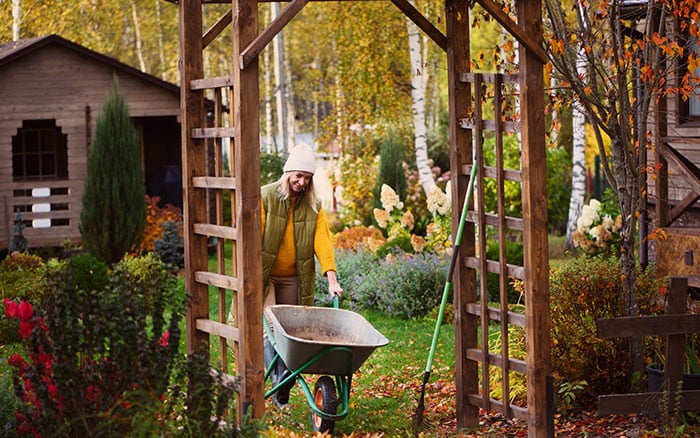Early autumn is a great time of year to walk around the garden assessing what worked well and what wasn’t quite so successful with a view to planning changes for the following year.
Shrubs, particularly evergreen ones, are a great way of adding year round interest and impact to an existing or new garden with silver, gold and variegated leaf colour varieties to choose from as well as different shades of green!
There’s a great choice of heights too; from low growing Plumbago (Ceratostigma plumbaginoides) to mid size, scented flower Daphnes (Daphne tangutica) and statuesque Californian lilac (Ceanothus ‘Concha’), many of which are low maintenance, making them ideal choices for most busy gardeners.
Likewise if you’ve decided you’d like a bit more privacy from your neighbours, or to screen off a part of the garden, autumn is also an excellent time to plant an evergreen conifer hedge.
Why plant now?
Autumn is an ideal time to plant shrubs as the soil should still be warm from the summer sun and relatively easy to dig prior to planting.
The soil tends to stay more wet during autumn and winter months, meaning you won’t have to water newly planted shrubs as much as those planted in the spring and summer.
Evergreen shrubs, as well as deciduous ones, and conifers, all tend to enter a dormant phase from late autumn until spring, and so planting now should give their roots a chance to settle in before the winter cold hits and an earlier growth spurt in spring than those planted in March or April.

Bare root or container grown
It’s possible to buy shrubs and conifer hedging plants bare root between late autumn and early spring. Bare root means that the plants have been dug out of the field and all soil removed from their roots.
The plant nursery saves on the cost of compost and containers and, as a result, can sell them at a cheaper price than containerised plants. They also cost less to post and so delivery charges can be lower too!
The important thing to remember with bare root shrubs is not to overly expose the roots to the air.
So all you need to do is keep them in their delivery wrapping in a cool, dark place until you’re ready to plant them.
If bad weather means you’re unable to plant them in your chosen area after a couple of days then it’s best to put them in a deep pot with the roots completely covered in soil or compost as a temporary measure.

Conditions for planting
Make sure the soil isn’t too waterlogged or excessively dry before planting.
If the soil’s too dry place a hose over the planting area so that it’s letting out just a slight trickle of water and leave until the water has percolated down to the depth of the pot that the shrub is currently growing in or, if it’s bare root, the depth of the roots to the base of the stem.
If waterlogged then patience is needed to wait until the soil has dried out.
How to plant
Planting is easy if you follow a few simple steps!
Make sure the hole you dig is deep and wide enough to accommodate the root ball of the plant and remember to soak the plant for at least an hour before planting.
Add garden compost or tree and shrub compost to the soil in the planting hole and mix in well using a garden fork.
Here’s a top tip!
Save money and use the compost from your summer plant bedding containers after you’ve removed the bedding plants.
Make sure the base of the plant is at the same level as the soil surface; if it’s too high then remove more soil; too low, add more soil to the planting hole base as soil firmed too high can rot the plant stem(s).

When you’re happy with the planting hole size, loosen the base and sides inside the hole as this will help the plant’s roots spread into the surrounding soil more easily.
Loosen the plant’s roots before placing it in the hole; add soil to the sides of the plant, making sure you firm it in all around it, but not over-firmed as you want water to be able to flow through the soil!
Once planted water thoroughly all around the base of the plant.
Choose the best evergreen shrubs and hedges to give your garden some lovely colour variations this October.

Leave A Comment